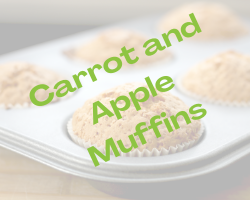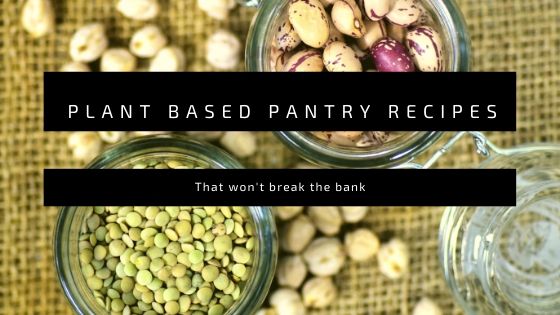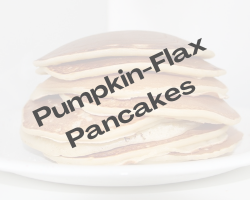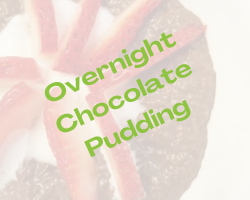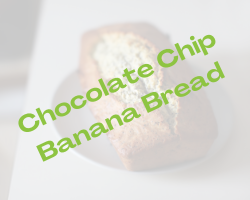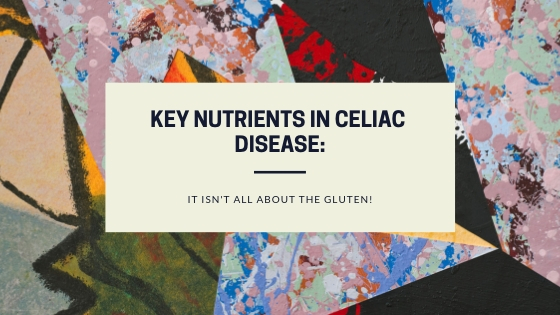Blog
Plant Based Pantry Recipes that won’t break the bank
When the world ended as we knew it I was determined to cook up lower cost, plant based meals and chalk my freezer full. I wanted to have a great stock pile so that when I eventually returned to work I would have so many …
Pumpkin-Flax Pancakes
Pumpkin-Flax Pancakes
Ingredients
- 1 cup milk
- 1/2 cup pumpkin puree (canned or fresh)
- 1 egg
- 1 1/2 tbsp unsalted butter, melted and cooled slightly
- 1 tsp pure vanilla extract
- 1 cup whole wheat flour
- 1/4 cup ground flax seed
- 1 tbsp granulated sugar
- 1/2 tbsp baking powder
- 1/4 tsp baking soda
- 1/4 tsp nutmeg
- 1/4 tsp ground ginger
- 1/4 tsp ground cinnamon
- 1/4 tsp ground cloves
- 1/4 tsp salt
- Yogurt and chia seeds for serving (rather than syrup)
Instructions
- To a large bowl, add the milk. Add the pumpkin, eggs, butter, and vanilla and stir with a whisk to combine.
- In a medium bowl, stir together the flour, ground flax seed, sugar, baking powder, baking soda, spices, and salt.
- Pour the dry ingredients over the wet and mix just until incorporated. Do not over mix.
- Cook in a frying pan over medium heat (wait for the frying pan to heat up before adding batter). Melt a little butter on the cooking ,surface spreading it evenly, if desired (if the surface is non-stick, you may not need to do this). When the frying pan is heated, use a spoon or ice cream scoop to pour batter. The pancakes are ready to flip when they look a little dry around the edges and start to form little bubbles, 1 to 2 minutes. Flip and cook on the other side until golden brown and completely cooked through, 1 to 2 more minutes.
- Serve topped with yogurt (plain or vanilla) and chia seeds.
Overnight Chocolate Pudding

Overnight Chocolate Pudding
Ingredients
- 1 1/4 Cup Milk
- 1/4 Cup Chia seeds
- 2 Tbsp Cocoa powder
- 1 Tbsp Honey or maple syrup
Instructions
- Add all of the ingredients together in a bowl and mix well.
- Pour into a container with an air tight lid.
- Refrigerate overnight.
- Stir before serving.
Key Nutrients in Celiac Disease: It isn’t all about the Gluten!
Hey! Did you hear that it’s Nutrition Month yet? Maybe you have been blasted all over social media with tons of posts so you already know. If you didn’t know….well…March is Nutrition Month! A Dietitian’s goal every day is to teach people about healthy eating, but Nutrition Month is like our Christmas. We get extra creative and extra loud because we can share our experiences, our knowledge, our tips and tricks and maybe even some of our failures! This year the theme is Unlock the Potential of Food. Simply put…food has limitless potential. Its about so much more than satisfying our hunger! For the purposes of this blog though, I would like to focus in on food’s potential to heal.
If you are new to this diagnosis or you have no idea what Celiac Disease is,
Celiac Disease is an auto immune disease that can cause damage to the small intestine when Gluten is consumed. This damage can lead to nutrient deficiencies which can cause further health complications down the line. Gluten is found in wheat, rye, barley and their hybrid strains.
I often hear…”Have you tried gluten free? We’ve gone gluten free.” as I’m walking through the grocery store or just doing things like standing in line for coffee. I find that there is absolutely nothing wrong with this statement or with the actual act of going gluten free itself. I only ask that people are cautious when it comes to changing their diet. I have heard people say that going gluten free really helped them. Hey…I can’t argue with that! The one thing I ask though, is that you make sure you have ruled out potential health considerations before changing something that might not be helpful.
The Gluten-free diet itself isn’t necessarily a healthy one. Gluten-free foods are not fortified with the same nutrients and they tend to be higher in fat and sugar than their gluten containing counterparts. Individuals who have Celiac might also have many nutrients deficiencies from years of damage to their intestines and they are also susceptible to other autoimmune diseases as well as other health complications in general. That is why it’s extremely important to get the proper diagnosis. The proper diagnosis means proper follow-up throughout your life span.
Why is proper Diagnosis important
If you ACTUALLY have Celiac Disease
- your first degree relatives have a 10-15% increased chance of having this disease. Your proper diagnosis will help your family members and potential future children as well. You’re not the only one affected.
- you must remain on a gluten free diet for life. This is currently the only treatment. This means no cheating at restaurants and special occasions. Consuming gluten can do real damage to your intestines which can lead to other health issues down the line. The more times you “Cheat” on your gluten free diet, the higher your chances of developing another autoimmune disease like Diabetes or Thyroid Disease.
- you are at a higher risk of developing some cancers, osteoporosis, infertility and some nutrient deficiencies. These chances become more likely if you continue to eat gluten or “cheat” on your diet.
- you need to talk to a Dietitian. The gluten free diet on its own is not complete and its important to fill in the gaps and find out what nutrients are important to keep you strong and healthy and living your best life.
Nutritional Considerations
This is where I wanted this blog to lead. Having Celiac Disease and being on a Gluten free diet means there are certain nutritional considerations you need to be aware of, both at diagnosis and long term.
At Diagnosis you may have deficiencies or issues with some of the following nutrients
- Iron
- B Vitamins (Folate and B12)
- Lactose Intolerance
- Calcium
- Vitamin D
- Zinc
Lifelong you will certainly still have to be aware of the above nutrients but we also want to focus on others like:
- Fibre
- Added Sugar
- Fat Content
Iron Deficiency
Iron deficiency can be an issue at diagnosis but also potentially throughout the lifespan. For some people this was the only symptom that indicated Celiac disease. Women have a higher risk of developing iron deficiency as they tend to lose more blood than their male counterparts. You should monitor these levels as they can pinpoint a flare-up or accidental ingestion of gluten long term. Its important to note that one accidental exposure will not cause enough damage to cause deficiencies, we are more worried about repeated exposure over time. To increase your iron stores or keep them up long term, focus on iron rich foods.
There are two types of Iron
- Heme iron is very well absorbed in the body. Its found in meat, fish and poultry.
- Non-Heme iron is not absorbed in the body efficiently and requires Vitamin C for optimal absorption
***If iron deficiency persists or is extremely low to start, consider talking to your doctor about a supplement
***Avoid drinking coffee or tea and dairy products with non-heme iron rich foods as these can decrease absorption
| Non-Heme Sources of Iron (plant sources) | Food Sources of Vitamin C |
| Nuts | Bell Peppers |
| Seeds | Broccoli |
| Legumes | Red Cabbage |
| Dark Green Veggies | Brussel Sprouts |
| Oatmeal | Kiwi |
| Black Strap Molasses | Oranges |
| Quinoa | Strawberries |
| Nutritional Yeast | |
Snack Ideas Incorporating Non-heme iron and Vitamin C for optimal absorption
- ¼ cup Pumpkin Seeds + Orange slices
- ¼ cup hummus or black bean dip + ½ cup peppers and baby tomatoes
- 1/3 cup homemade trail mix with nuts, seeds and dried fruit
- ½ cup oatmeal with chopped strawberries on top
- Homemade granola bars + kiwi (recipe here)
Folate and Vitamin B12
The levels of these nutrients should increase as healing progresses. Gluten containing foods are often fortified with these nutrients but the same cannot be said for gluten-free foods. Your doctor should monitor these levels if a flare up occurs. Folate is particularly important for pregnant woman as it can help prevent neural tube defects.
If levels do not increase with food consumption supplementation maybe necessary.
| Food Sources of Folate | Food Sources of Vitamin B12 |
| Some GF Flours | Meat, poultry and fish |
| Flaxseed meal | Milk, yogourt and cheese |
| Rice | Nutritional yeast |
| Steel cut oats | |
| Lentils | |
| Chick Peas | |
| Beans (Pinto, Black, etc) | |
| Nuts and Seeds | |
| Spinach (most green vegetables) | |
| Nutritional Yeast |
Lactose Intolerance, Calcium & Vitamin D
Lactose intolerance is common in newly diagnosed patients but tolerance usually returns as the gut heals. There is no need to avoid dairy however, you can simply just choose the many lactose-free options that are widely available.
Calcium and Vitamin D status is often low at diagnosis and throughout. This is probably due to multiple factors including malabsorption from years of waiting for a diagnosis and decreased intake of dairy because it causes unpleasant symptoms due to intestinal damage.
Bone density can also be affected so its important to insure that your doctor has this on his/her radar!
| Non-Dairy Sources of Calcium | Food Sources of Vitamin D |
| Fortified beverages (i.e. soy milk) | Cod Liver oil |
| Tofu (with calcium sulfate) | Fortified beverages |
| Almonds | Canned salmon with bone in (pink and sockeye) |
| Canned sardines and salmon with bone in (pink and sockeye) | Mackerel (cooked) |
| White beans (cooked) | Mushrooms (exposed to UV light) |
| Collards (cooked) | Yogourt (with Vitamin D added) |
Zinc
Micronutrients and minerals can also be low in newly diagnosed, specifically, calcium, phosphorus, copper, selenium, and zinc. All of these are absorbed in proximal duodenum where a lot of damage can occur. Zinc deficiency is the most common and symptoms include; dry skin, thinning hair, and brittle nails. Luckily, symptoms usually improve as the gut heals
Food sources of Zinc
- Dairy (Cheese, yogurt, Greek yogurt and milk)
- Seafood (Oysters, crab, lobster)
- Meat (liver, veal, venison, beef and lamb)
- Nuts without the shell (Pine, peanuts, cashews, soy and almond) and Seeds (sunflower, pumpkin and squash)
- Dried, cooked beans, peas and lentils (chickpeas/garbanzo beans, black- eyed, split peas)
Fibre/Sugar
The gluten free diet is notoriously low in fibre and high in sugar. The recommended intake of daily fibre is 21-38 grams per day. Make sure you increase intake slowly and add additional fluids, preferably water.
Choose foods high in fibre and natural sugars and spread them throughout the day
- Fruits and vegetables
- Beans, peas and lentils
- Flours, pasta, crackers made from whole grain or high fibre grains, i.e. brown rice flour, bean flours, and oat flour
- Gluten Free Oats
- Ground Flaxseed
- Chia Seed
- Pysllium
- Nuts and other seeds
Snack and Meal Ideas
- ½ cup yogourt with 1 Tbsp each of ground flaxseed and chia seeds
- ¼ cup oatmeal with 1 Tbsp each of ground flaxseed and chia seeds
- Add ground flax to different sauces, sprinkle on pizza or casseroles before adding cheese
- Nuts, seeds and their butters paired with fruit, i.e. apple and peanut butter
- Aim to have 2 vegetarian meals each week using beans or lentils (Vegetarian chili, black bean burgers, chick pea salad)
- 1 piece of fruit or 1 cup of chopped fruit or veggies with each meal (raw)
- ½ cup cooked veggies with Lunch or Supper
- Make your own baked goods using high fibre flour (brown rice, buckwheat, bean or oat), beans and lentils and try subbing ground flaxseed in for flour 3:1 ratio
- Always half sugar in any recipe
Fat
The gluten free diet can be high in unhealthy fats. Excess fat is often used to improve the texture of gluten free foods. If you are purchasing a lot of pre-packaged baked goods, cookies, and granola bars then this is something you need to be concerned about.
Choose foods low in unhealthy fat or high in heart healthy fats
- Low fat dairy products
- Lean cuts of meat
- Fish (salmon, mackerel, tuna)
- Nuts and Seeds
- Avocado
- Canola and Olive Oil
- Chia seeds
- Ground flaxseed
Meal and Snack Ideas
- ¼ cup of nuts or seeds
- 1 Tbsp of chia and flax to yogurt or oatmeal
- Crackers with 2 oz of low fat cheese
- Aim to have fish 2 times per week
- Use canola oil in cooking and baking
- Use olive oil to make your own salad dressings
- Use Avocado as a spread instead of mayo
- Choose Greek yogurt rather than sour cream
- Make your own baked goods using new Becel margaine or canola oil
So there you have it. I want to emphasize again that its extremely important to get your Celiac Diagnosis because of the above nutrition implications. If you are experiementing with a Gluten-free diet or cutting other things out of your diet…always remember…if you take something out, add something in…otherwise you might be missing some key nutrients!
Check out www.celiac.ca for tons of great information!
Hope that helps! Happy Nutrition Month everyone!
Folate & Celiac Disease: Ten food sources to add folate to your diet every day!
There are two types of Vitamins, Fat Soluble and Water Soluble. Our fat soluble Vitamins include; Vitamins A, D, E and K and our Water soluble vitamins make up all the rest. Fat soluble vitamins can be stored in the body for later use when …

